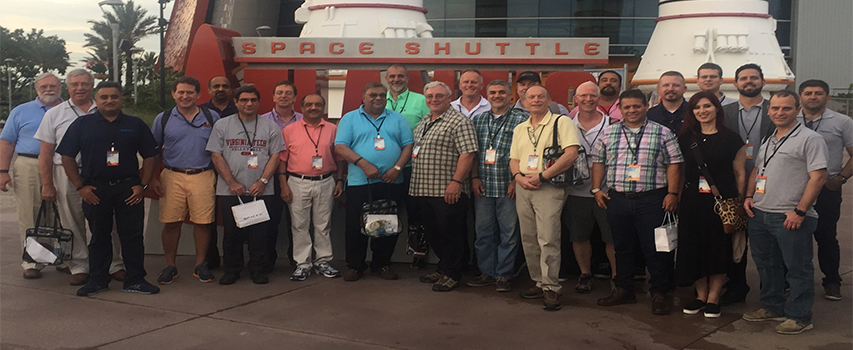
Members of Hughes Network Systems on site at Kennedy Space Center in Cape Canaveral, Florida, for the launch of Hughes 63 West.
On July 22, 2018, in the early morning hours, a SpaceX Falcon 9 rocket shook the Florida coast as it blasted off from Cape Canaveral. Tucked safely inside the 46’ high fairing was the 7-ton Telstar 19 VANTAGE satellite containing the Hughes 63 West hosted payload. For SpaceX, it was the storybook finale for their team successfully launching the satellite belonging to their client, Telesat. For Hughes Network Systems, the picture-perfect launch was not so much a finale as the start of something new and exciting.
The anticipation had been building for years. In 2015, Hughes signed an agreement with Telesat for high-throughput capacity on the planned Telstar 19 VANTAGE satellite. Consistent with its mission to bring satellite Internet to those unserved and underserved by wireline and wireless providers, Hughes took the opportunity to partner with Telesat in order to bring substantial satellite broadband coverage to five countries in South America. Hughes 63 West is designed to complement the Hughes 65 West capacity already in service over Brazil, enhance the JUPITER 2 satellite services currently available in Colombia, and bring new broadband connectivity to Peru, Ecuador and Chile.
Over the past two and a half years, Hughes engineers have collaborated closely with Telesat and manufacturer SSL to design and build a high-throughput Ka-band payload optimized to serve bandwidth-intensive applications. Simultaneously, engineers designed and constructed two new JUPITER gateways – one in Brazil in one in Chile – to enable service delivery.
The long-awaited launch was a significant milestone – and it did not disappoint.
In the hours leading up to the launch, the Hughes team – including many who had worked on the design and construction of the payload; some that developed the complementary ground network; and business leads from the U.S., Colombia and Brazil – gathered at the Kennedy Space Center in Cape Canaveral. The legendary airbase has hosted moon launches, space shuttle expeditions and missions to the International Space Station. But on July 22, the only mission that mattered was the Telesat 19V.
Despite early rain and evening lightning warnings, the skies cleared in time for the countdown, and with “all systems GO,” the Falcon 9 rocket lifted off at the beginning of the launch window, and within 37 minutes, gracefully deposited the satellite into geostationary transfer orbit (GTO). (You can watch a replay here.)
From here, it’s only a matter of weeks until the payload is fully tested and HughesNet service lights up for the first time over Ecuador, Chile and Peru. Once in service, Hughes 63 West will enable satellite Internet for more than 90% of the populations of those three countries and Brazil, and more than 96% of the population of Colombia.
HughesNet broadband services for businesses and residences via Hughes 63 West will support download speeds up to 50 Mbps and upload speeds up to 15 Mbps. Moreover, Hughes 63 West will deliver managed enterprise services as well as community Wi-Fi broadband services to enable governments to bridge the digital divide in the region. Cellular backhaul for mobile network operators (MNOs) will provide for rapid and cost effective deployment of 2G, 3G and 4G services everywhere within the footprint of the Hughes 63 West payload.
JUPITER™ System technology from Hughes will be deployed for the ground system and customer premises equipment to deliver broadband services on Hughes 63 West, with the new gateways in Brazil and Chile complementing the five JUPITER System gateways in the U.S. The JUPITER System is the world’s most widely deployed satellite broadband system and supports over 1.2 million HughesNet subscribers in North and South America today. Supporting high performance terminals with the demonstrated ability to achieve 200 Mbps TCP throughputs, the JUPITER System supports a wide range of applications including consumer and small- and medium-sized business (SMB) broadband Internet service, community Wi-Fi, cellular backhaul, managed network services and mobility, including aeronautical services for in-flight Wi-Fi.
The countdown to the launch may be over, but at Hughes, we are counting down to when Hughes 63 West service begins, ushering in a new era of connectivity in Brazil, Chile, Colombia, Ecuador and Peru.